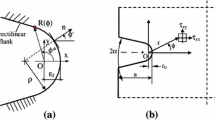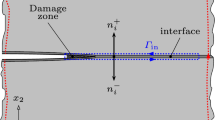Abstract
The “energy density theory” of G. Sih is extended to investigate the direction of initial crack extension at the tip of blunt cracks (notches) in combined Mode 1-Mode 2 loading. Three different governing strain energy density functions are postulated for comparison, and each is applied to the ideally sharp and the blunt notch cases. It is found that the sharp and blunt notch solutions agree in the limits of pure Mode 1 loading, but their difference grows as K 1/K 2 value is decreased and becomes most conspicuous in the limit of pure Mode 2 loading. It is also found that the above solution difference is greatest near the crack tip and diminishes at a large distance from the crack tip. For both the sharp and blunt notch solutions, the deviatoric strain energy density function predicts a larger absolute value of the critical angle θc than does the total strain energy density function. The results are compared with those obtained by using the classical method of “maximum tangential (tensile) stress” for predicting the crack trajectories.
Résumé
On étend la théorie de densité de l'énergie de G.Sih à l'étude de la direction de l'extension initiale d'une fissure à l'extrémité de fissures non aigües (entailles) sollicitées par une combinaison de contraintes de modes 1 et 2. Pour établir une comparaison, on postule trois différentes fonctions de base de la densité d'énergie de déformation. Chacune est appliquée aux cas d'une entaille idéalement aigüe et au cas d'une entaille peu aigüe. On trouve que les solutions pour l'entaille aigüe et pour l'entaille arrondie sont en accord tant que l'on est en pur mode 1 de sollicitation, mais que des différences se marquent de plus en plus au fur et à mesure que le rapport K 1/K 2 décroit, jusqu'à devenir frappantes dans le cas d'une sollicitation en mode 2 uniquement.
On trouve également que les différences en question sont les plus grandes au voisinage de l'extrémité de la fissure, mais qu'elles se réduisent à une grande distance de cette extrémité. Pour les deux cas d'entailles envisagées, la fonction de densité d'énergie de déformation déviatoire permet de prédire une valeur absolue de l'angle θc plus élevée que ne le fait la fonction de densité d'énergie de déformation totale.
Les résultats de cette analyse sont comparés avec ceux qui résultent de l'utilisation de la méthode classique de la tension tangentielle maximum, pour décrire les trajectoires de fissuration.
Similar content being viewed by others
References
G. C. Sih, A Special Theory of Crack Propagation, Methods of Analysis and Solutions of Crack Problems, edited by G. C. Sih, Noordhoff International Publishing Company, Groningen (1972).
G. C. Sih and E. P. Chen, Journal of Composite Materials, 7 (1973) 230–244.
M. E. Kipp and G. C. Sih, International Journal of Solids and Structures, 11 (1975) 153–173.
M. Creager and P. C. Paris, International Journal of Fracture Mechanics, 3 (1967) 247–252.
G. C. Sih, Application of Strain-Energy-Density Theory to Fundamental Fracture Problems, Technical Report AFOSR-TR-73-1 (1973).
Author information
Authors and Affiliations
Rights and permissions
About this article
Cite this article
Francis, P.H., Ko, W.L. The effect of root radius on the direction of crack extension under combined mode loading. Int J Fract 12, 243–252 (1976). https://doi.org/10.1007/BF00036982
Received:
Issue Date:
DOI: https://doi.org/10.1007/BF00036982




